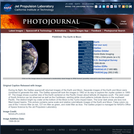
Photo of the Earth & Moon created from images from the the Galileo spacecraft.
- Subject:
- Astronomy
- Physical Science
- Material Type:
- Diagram/Illustration
- Primary Source
- Provider:
- NASA
- Date Added:
- 06/04/1998

Photo of the Earth & Moon created from images from the the Galileo spacecraft.
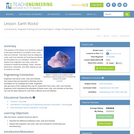
The purpose of this lesson is to introduce students to the basic elements of our Earth's crust: rocks, soils and minerals. They learn how we categorize rocks, soils and minerals and how they are literally the foundation for our civilization. Students also explore how engineers use rocks, soils and minerals to create the buildings, roads, vehicles, electronics, chemicals, and other objects we use to enhance our lives.
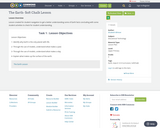
Lesson created for student navigation to get a better understanding some of Earth facts concluding with some student activities to check for student understanding.

This video segment adapted from NASA's Goddard Space Flight Center shows how integral satellites are to everyday life and describes the different types, including orbital and geostationary.
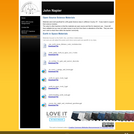
Several power points, quiz, study guide, and worksheets about the Earth, Moon, Sun relationships. I developed these for 6th grade science class as support for other materials. Items are great for visual learners and include concepts of scale, seasons / earth tilt, and path of the sun.

Students learn about the structure of the earth and how an earthquake happens. In one activity, students make a model of the earth including all of its layers. In a teacher-led demonstration, students learn about continental drift. In another activity, students create models demonstrating the different types of faults.
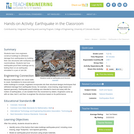
Students learn how engineers construct buildings to withstand damage from earthquakes by building their own structures with toothpicks and marshmallows. Students test how earthquake-proof their buildings are by testing them on an earthquake simulated in a pan of Jell-O(TM).

Students learn the two main methods to measure earthquakes, the Richter Scale and the Mercalli Scale. They make a model of a seismograph a measuring device that records an earthquake on a seismogram. Students also investigate which structural designs are most likely to survive an earthquake. And, they illustrate an informational guide to the Mercalli Scale.
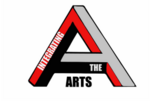
This resource was created by Judy Prewett, in collaboration with Dawn DeTurk, Hannah Blomstedt, and Julie Albrecht, as part of ESU2's Integrating the Arts project. This project is a four year initiative focused on integrating arts into the core curriculum through teacher education, practice, and coaching.
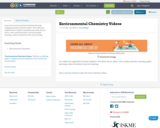
Learn about environmental chemistry through engaging, bitesize animated videos. The videos are organised into chapters including: the earth, the air, water, rocks, metals and their reactivity, global warming, carbon chemistry, fuels and recycling.

This course is designed to be a survey of the various subdisciplines of geophysics (geodesy, gravity, geomagnetism, seismology, and geodynamics) and how they might relate to or be relevant for other planets. No prior background in Earth sciences is assumed, but students should be comfortable with vector calculus, classical mechanics, and potential field theory.
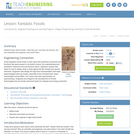
Students learn about fossils what they are, how they are formed, and why scientists and engineers care about them.

In this activity, students are introduced to faults. They will learn about different kinds of faults and understand their relationship to earthquakes. The students will build cardboard models of the three different types of faults as they learn about how earthquakes are formed.

The Fifth Grade Elementary Framework for Science and Integrated Subjects,Earth and Space: Patterns in the Sky, uses the phenomena of perceived sun and moon movements that seem to move around the Earth to explore stars, Earth orbit and rotation and moon orbit around Earth. It is part of Elementary Framework for Science and Integrated Subjects project, a statewide Clime Time collaboration among ESD 123, ESD 105, North Central ESD, and the Office of Superintendent of Public Instruction. Development of the resources is in response to a need for research- based science lessons for elementary teachers that are integrated with English language arts, mathematics and other subjects such as social studies. The template for Elementary Science and Integrated Subjects can serve as an organized, coherent and research-based roadmap for teachers in the development of their own NGSS aligned science lessons. Lessons can also be useful for classrooms that have no adopted curriculum as well as to serve as enhancements for current science curriculum. The EFSIS project brings together grade level teams of teachers to develop lessons or suites of lessons that are 1) pnenomena based, focused on grade level Performance Expectations, and 2) leverage ELA and Mathematics Washington State Learning Standards.
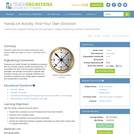
Students create their own simple compasses using thread, needle and water in a bowl and learn how it works.
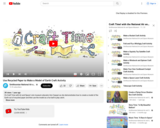
Use newspaper and paint to create a model of planet Earth that you can play with
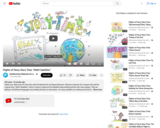
Earth is trying to sleep but the Satellites keep bothering Earth with noisy signals. They are talking in all different languages and sending all kinds of information.
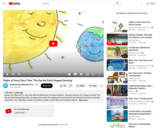
This story is about the orbiting and revolving Earth.
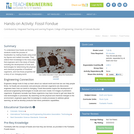
To understand how fossils are formed, students model the process of fossilization by making fossils using small toy figures and melted chocolate. They extend their knowledge to the many ways that engineers aid in the study of fossils, including the development of tools and technologies for determining the physical and chemical properties of fossilized organisms, and how those properties tell a story of our changing world.
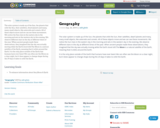
The solar system is made up of the Sun, the planets that orbit the Sun, their satellites, dwarf planets and many, many small objects, like asteroids and comets. All of these objects move and we can see these movements. We notice the Sun rises in the eastern sky in the morning and sets in the western sky in the evening. We observe different stars in the sky at different times of the year. When ancient people made these observations, they imagined that the sky was actually moving while the Earth stood still.The Moon is a natural satellite of the Earth, meaning that it orbits around the Earth.
It is the only place outside of the Earth that humans have ever been! We can often see the Moon on a clear night, but it does appear to change shape during the 29 days it takes to orbit the Earth.